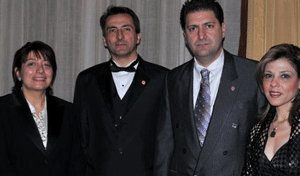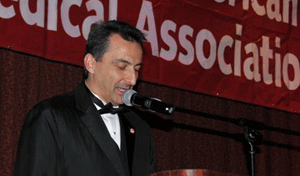Doctors Have Been Meeting at This Ball for 41 Years

Ali Serdar Karakurum, (second from the left) President of Turkish American Medical Association is with Kaya Boztepe, President of Federation of Turkish American Association and Ayse Turan, Medical Attache of Turkish Consulate General in New York.(Photo by Ridvan Sezer, turkishny.com)
In 1950’s and 1960’s, many doctors and engineers came to the USA from Turkey, creating a new trend, among the educated, of moving to the continent. During the years after WWII, economic and military relations between the USA and Turkey played an important role in the arrival of 4,000 Turkish engineers and doctors to this country.
Prior to this trend of migration of doctors and engineers, between the years of 1820 and 1950, nearly 360,000 people migrated to the USA from the Ottoman Empire and the Republic of Turkey. About 45,000 to 65,000 of this group consisted of Muslims and Turks.
The doctors and engineers that came during the second wave of migration, which followed the earlier migration that started during the last years of the Ottoman Empire, began to assemble in the USA through associations.
The “Doctors’ Ball,” which took place for the first time in 1968 in New York, is a traditional event that the doctors have been trying to continue ever since. Because the Turkish population during the 1970’s was small, this ball, which was organized every year in March, used to carry a special meaning for Turks, since they could get together, even if it was only once a year, and ease their longing for home. As years passed by, it lost its initial popularity.
IT WAS THE MOST IMPORTANT EVENT
Turgay Kadioglu, a Turkish businessman who attended the ball at the end of the ‘70’s with his family, describes it as an event that was awaited impatiently throughout the year and as one of the largest Turkish organizations in New York, then. “People would come to the ball all dolled up and it used to be very crowded. There would not be a special guest artist from Turkey but, rather, local artists would entertain,” says Kadioglu. Even the name of the artist who took the stage during those years is remebered by Kadioglu: Tarik Bulut.
Mihri Cakir, who lives in California, mentions how the ball she went in 1971 is still fresh in her memory. “The young adults would come to the ball with their families. In a way, they would be introduced to the community. People would dress quite elegantly and nicely and the ball was given great importance,” she says.

When the doctors who assembled under the organization Turkish American Medical Associations fell short of taking advantage of technological advancements, the bond between them also broke quickly. The current president of the organization is Ali Serdar Karakurum, who previously served as president twice. In addition to Karakurum, the other officers are Tolga Kapusuz, Ferda Hatipoglu, and Esra Hatipoglu, who make up the organization’s board.
One of Karakurum’s primary goals for his presidency, to which he was elected in May of last year, is to activate the organization’s website. A 1986 graduate of Ankara University Medical School, Karakurum has sent invitations to a total of 1060 people for the ball in March 2009. Expecting the participants to be around 100 people, Karakurum says he wants to form a database of the doctors and update their adresses. Karakurum has been the chair of the science department of Nassau University Medical Center for three years and also has his own private practice.
Karakurum came to the USA despite the warnings of his uncle, who is also a doctor here. He points out that as a result of the development in the health sector and the private sector’s innovative approaches in Turkey, the number of doctors coming to the USA to work has decreased over previous years. Dr. Karakurum added, "Turkey is doing very important work in developing the health sector. Many private hospitals were opened, and the new generation of doctors in Turkey don't need to come to the U.S. for work. Even most medical students prefer to go back to Turkey after completing their education."
The doctors and engineers that came during the second wave of migration, which followed the earlier migration that started during the last years of the Ottoman Empire, began to assemble in the USA through associations.
The “Doctors’ Ball,” which took place for the first time in 1968 in New York, is a traditional event that the doctors have been trying to continue ever since. Because the Turkish population during the 1970’s was small, this ball, which was organized every year in March, used to carry a special meaning for Turks, since they could get together, even if it was only once a year, and ease their longing for home. As years passed by, it lost its initial popularity.
IT WAS THE MOST IMPORTANT EVENT
Turgay Kadioglu, a Turkish businessman who attended the ball at the end of the ‘70’s with his family, describes it as an event that was awaited impatiently throughout the year and as one of the largest Turkish organizations in New York, then. “People would come to the ball all dolled up and it used to be very crowded. There would not be a special guest artist from Turkey but, rather, local artists would entertain,” says Kadioglu. Even the name of the artist who took the stage during those years is remebered by Kadioglu: Tarik Bulut.
Mihri Cakir, who lives in California, mentions how the ball she went in 1971 is still fresh in her memory. “The young adults would come to the ball with their families. In a way, they would be introduced to the community. People would dress quite elegantly and nicely and the ball was given great importance,” she says.

Ali Serdar Karakurum. (Photo by Ridvan Sezer, turkishny.com)
When the doctors who assembled under the organization Turkish American Medical Associations fell short of taking advantage of technological advancements, the bond between them also broke quickly. The current president of the organization is Ali Serdar Karakurum, who previously served as president twice. In addition to Karakurum, the other officers are Tolga Kapusuz, Ferda Hatipoglu, and Esra Hatipoglu, who make up the organization’s board.
One of Karakurum’s primary goals for his presidency, to which he was elected in May of last year, is to activate the organization’s website. A 1986 graduate of Ankara University Medical School, Karakurum has sent invitations to a total of 1060 people for the ball in March 2009. Expecting the participants to be around 100 people, Karakurum says he wants to form a database of the doctors and update their adresses. Karakurum has been the chair of the science department of Nassau University Medical Center for three years and also has his own private practice.
Karakurum came to the USA despite the warnings of his uncle, who is also a doctor here. He points out that as a result of the development in the health sector and the private sector’s innovative approaches in Turkey, the number of doctors coming to the USA to work has decreased over previous years. Dr. Karakurum added, "Turkey is doing very important work in developing the health sector. Many private hospitals were opened, and the new generation of doctors in Turkey don't need to come to the U.S. for work. Even most medical students prefer to go back to Turkey after completing their education."
Last modified onSaturday, 06 May 2017 10:07
Latest from Admin TOA
- From Dream to Reality, from Muş to Illinois: Zellano Home, the Largest Furniture Store Under One Roof in the USA!
- 300 migrants to be housed at shuttered Catholic church on Northwest Side in Chicago
- Turkish Stand-Up Sensation Hasan Can Kaya Embarks on U.S. Tour with Art Evi Production, in212 Production, and TAAS New York
- "Lean Startup, To Lean Company, To Rich Exit" by Dr. Kenan Sahin is released with Forbes Books
- LOSEV USA Ramadan Campaign Let the Children Heal First with Your Ramadan Donations
